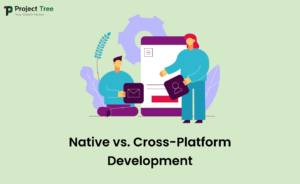Want to develop an effective mobile app? Selecting the right framework is important. With numerous choices accessible, it might be hard to find an appropriate competition. While developing a mobile app, you have to make an essential choice: select the right framework. Whatever you choose will affect how the application works, its scope, and your user experience. So, choosing properly can be difficult. In the following section, we’ll guide you through the most important factors to think about while selecting a structure for your app. It enables you to arrive at an option that is suitable to the objectives and demands of your project.
Understand Your Project Requirements
You must define the needs for the project before diving into the specifics of various frameworks. Evaluate some of these aspects:
Target Audience:
Identify the main operating systems for your mobile app, such as iOS, Android, or both. This allows you to choose between native and cross-platform frameworks.
App Complexity:
Assess the level of detail of the application you are developing. Small apps may benefit from simple structures, whilst complex apps may require strong frameworks that have multiple features.
Performance Needs:
Examine the app’s requirements for performance. Excellent-performance applications might need framework which have been adjusted for rapidity and effectiveness. Native vs Cross-Platform Software
Native vs. Cross-Platform Development

The first important decision involves deciding to use a native or cross-platform framework. Everyone comes with its advantages and disadvantages.
Native Frameworks:
Using platform-specific languages and tools, like Kotlin for Android and Swift for iOS, is referred to as native development. Native platforms frequently offer better performance as well as access to system-specific features, yet they need distinct code bases on every platform.
Cross-Platform Frameworks:
You can compose code only once while having it run on several platforms because of multi-platform framework. Popular choices include React Native, Flutter, and Xamarin. These frameworks can considerably reduce development time and cost, yet they may sacrifice performance and utilization of platform-specific features.
Evaluate Popular Frameworks
Here are some popular frameworks to consider, each with its own strengths:
React Native:
A popular cross-platform framework with a track record for speed and flexibility, React Native was created by Facebook. It allows developers to create iOS and Android apps with React and JavaScript. React Native has a large community and vast archives, making it a great option for multiple mobile app development.
Flutter:
The programming language Dart is used by Google’s Flutter. It’s known for its short creation cycle and expressive UI features. Flutter’s widget-based structure enables highly custom interfaces. It’s an excellent option if you’re looking to create stunning apps using one code base.
Xamarin:
The Microsoft-owned company Xamarin creates cross-platform applications using C# and.NET. It has an effective relationship with Microsoft’s surroundings, making it ideal for activities that require integrating using services from Microsoft or using Cs# abilities. It also allows access to native APIs, which ensures good performance.
SwiftUI:
SwiftUI, a new framework issued by Apple for iOS apps, provides a clear language for creating interfaces for apps. It works perfectly with Swift, who was offering a clean and efficient look at creating iOS apps utilizing modern design concepts.
Kotlin Multiplatform Mobile (KMM):
You can use Kotlin Multiplatform Mobile to transfer content between iOS and Android applications. It’s an innovative approach that combines native acceleration with cross-platform code sharing, which makes it a desirable option for uses that need both native performance and code reuse.
Assess Community Support and Documentation
The community support and information for the structure are crucial to its use and longevity. You’re going to have access to several assets, archives, and third-party tools if your network is active. Comprehensive documentation can help you in exploring the structure’s capabilities and solving problems easily.
Community:
Look for frameworks with regular improvements and engaged users. An involved community could provide significant help and maintain the structure current with the newest trends and technologies.
Documentation:
Getting the ability to access great documentation is essential for understanding how to use the framework effectively. Examine to determine if the framework provides broad directions, tutorials, and samples to help users get started or overcome typical issues
Consider Development Speed and Cost
The two primary variables to consider are growth speed and cost. Because cross-platform frameworks allow you to establish code only for different platforms, they often result in quicker development times and lower costs. But if you need special features or outstanding performance, native development could be well worth the extra cost.
Development Speed:
Determine the speed that it’s necessary to bring your software to market. Cross-platform frameworks often offer smaller phases of development, but native development can take longer because of the different programs.
Cost:
Keep in mind exactly how much money you need to invest in mobile app development. Frameworks for both platforms may decrease costs by reducing the need for different iOS and Android teams of developers. But the choice may also be affected by your app’s size and particular needs.
Test and Prototype
It is advisable to build models or conduct test flights before adopting to a structure. This approach allows you to check the structure’s relevance for the undertaking while implementing any modifications that are required before complete implementation.
Prototyping:
Using the selected framework, develop an early version of your application to verify that it fulfills your needs and test its abilities. It may help to identify any limitations or refers to early in the development process.
Pilot Testing:
Pilot testing is an effective way to collect input from a small number of users and verify the functionality and performance of the system. This input can offer essential knowledge to the user experience and help drive future development.
Conclusion
The performance, speed of development, and general popularity of your mobile app are all driven by the framework you select. We can arrive at an educated choice by recognizing the project’s requirements and evaluating all of the possibilities while taking into consideration aspects like public backing and price.
Projecttree offers comprehensive mobile app development services for companies that require expert guidance on the development of mobile apps. Our talented developers can assist you with choosing the best framework and make sure your app is customized to your specific requirements and goals.
Explore how Project Tree’s innovative development solutions power seamless integration and efficient workflows in healthcare through our collaboration with DrPro, the leading Hospital Management System platform.
FAQs
Q1. What is the difference between native and cross-platform frameworks?
Native frameworks are designed for specific platforms (iOS or Android) and offer optimal performance and access to platform-specific features. Cross-platform frameworks allow for a single codebase to be used across multiple platforms, balancing performance with development efficiency.
Q2. How do I choose between hybrid and cross-platform frameworks?
Hybrid frameworks use web technologies within a native container and are suitable for simpler apps or when speed and cost are priorities. Cross-platform frameworks offer near-native performance and are better for more complex apps requiring high performance and rich user experiences.
Q3. What factors should I consider when evaluating a mobile app development framework?
Consider factors such as your app’s requirements (platform support and features), performance needs, community support, integration capabilities, and long-term viability.
Q4. How important is community support for a development framework?
Community support is crucial as it provides access to troubleshooting resources, learning materials, and updates. A strong community can significantly ease the development process and offer valuable insights.
Q5. Can I test a framework before making a decision?
Yes, testing a framework by creating a prototype or small project can help assess its ease of use, performance, and compatibility with your app’s needs. This trial phase ensures you choose a framework that best fits your requirements.

